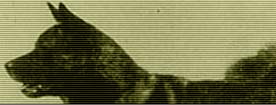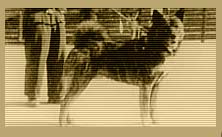 Save this page (93.1 kb)
Save this page (93.1 kb)
AKITAINU TAMAKUMO GO
By Katsusuke Ishihara
The greatest Akita of the past from the Akita area (Northern Japan) was Goromaru Go, and from the Kanto area (Tokyo area), came Tamakumo Go. Tamakumo Go was born out of Sire, Arawashi Go of Mitsuo Kennel, and Dam, Sansho Go, on December 13, 1950. He was a rich, black brindle with an exceedingly well-balanced structure. His facial features were marked by a pair of well shaped ears; a broad, flat forehead; dark, deep-set eyes; a straight bridge (of the nose); and a well drawn mouth. The stop was a little to pronounced but did not detract from the over-all quality of his facial features. Some people felt the pronounced stop gave Tamakumo a more distinct appearance. Although his neck was strong and powerful, the neck of Tamakumo's litter brother, Sachinishiki Go, was better developed. The breadth and depth of Tamakumo's chest was outstanding and was well supported by his powerful legs. The angle of his front wrist seemed a little shallow and his grips were not as large when he was younger, but they seemed to correct themselves as he grew older. Of all his features, the condition and color of his coat was the most outstanding
Although many had thick coats, the coat of the Akitainu, before Tamakumo, lacked the distinction between the coarse Guard coat and the Wooly under-coat. The beautiful black brindle color of Tamakumo was not only impressive, but the quality of having two distinct types of coats (1) was, without question, the most outstanding feature and a trait which I was determined to pass on to future Akitas.
When all the Japanese breeds were beginning to be recognized, during the early part of the Showa Era (1925), there were few dogs that possessed what was considered the standard in each breed. In the case of the Akita Breed, the Akita breeders of old, in the Odate area, had an image of a standard Akita. This image or standard differed considerably from those held by others in other areas for other large breeds. As research of the Akita Breed progressed, it became evident that there was cross-breeding among the Akitas. For this reason, there were those who felt that the Akitas should not be considered the representative of the large sized Japanese Breeds. However, the true Akita lovers believed that despite such cross-breedings, it would be possible to breed the original qualities, back into the Akitainu through selective breeding. Thus, the effort to purify the breed was begun. Gradually the Akitainu was standardized to a point where, today, the Akita breed may be considered pure. This is not to say that the goal has been attained. Some people felt that purification occurred before the Second World War. However, the devastation to the breed caused by the War stopped all arguments as to when purification occurred, as most of the work done prior to the War was lost.
With the end of the War, new breeders emerged and the original purpose and goals to improve the Akita Breed seemed to be temporarily side-tracked. This was a period when, once again, the large, sloppy Akitas became popular. However, as time went by, the true form of Akitas reappeared in Goromaru Go and Tamakumo Go. There were many other Akitas which contributed towards the improvement of the breed. However, the aforementioned two Akitas constitute the two main lines of Akitas today. Goromaru Go, thus, is the most important dog in Northern Japan, and Tamakumo Go is his counterpart in the Kanto (Tokyo) area.
When Tamakumo Go was first entered in the Nihonken Hozonkai Show (6-10 month class) and placed only in the Junyu Class, his owner, Mr. Tadamoto was very disappointed. It was generally believed, at that time, that the true large sized Japanese breeds should be large and heavy (there are those who still persist in this school of thought). Therefore, the more lean, muscular Tamakumo Go was considered below standard. Tamakumo's lean musculature was a result of a training-exercise program where Mr. Tadamoto, utilizing a small wheeled bicycle, ran Tamakumo about 15 kilometers daily beginning in the fifth month.
When the third Akitainu Kyokai Headquarter's Show was held at the Tokyo Seimei ground in Shinjiku-ku of Tokyo, Mr. Miyoshi Fujioka and I representing Tokyo, and Mr. Eikichi Hiraizumi (2) and Mr.Teikichi Toyama representing Akita-Ken, were the judges. Tamakumo Go distinguished himself by placing seventh over-all in the Wakainu Class (10-18 month class). In order to step up the pace of training, Mr. Tadamoto bought a women's bicycle (3) and continued the running exercise daily.
Mr. Hirokichi Saito, then Managing Director of the Animal Preservation Society, and also the Founder of Nihonken Hozonkai, proposed that Tamakumo Go's photo be sent to all the kennel clubs of the world including the AKC and the BKC as the most representative of the large sized Japanese dog. Accordingly, 50 photos of Tamakumo Go were developed by Mr. Tadamoto and the proposal was carried out. This incident affirms my contention that Tamakumo was thought to be the best of his breed by a few people. However, the brindle color was not popular at that time. The reason, perhaps, was because the better dogs were either red, goma, or white. Furthermore, it was felt, at the time, that the color of the coat should be standardized. Although there were brindle colored Akitas such as Tochi Nigo and Ichinoseki Tora, both contributing heavily to the development of the Akita Breed, this was the period when Goma colored Akitas such as Kongo Go was most popular. Many brindle colored Akitas with good qualities were, thus, overlooked.
After consulting me about showing Tamakumo in the Akitainu Hozonkai shows, Mr. Takamoto, first entered him in the Akita-Ken Southern Branch Show. He won first place in the over-all. In successive weeks Tamakumo was entered in the Akiho Headquarters Show (I did not judge in this show) held in Odate City. Tamakumo not only placed First, Over-All, but also won the Meiyosho. This was the beginning of the recognition of the brindle colored Akitas. As a result of Tamakumo Go's top placements, the brindle color gained-immediate popularity. Until this time, there were people in the Kanto and Western regions of Japan who said that the brindle was not a true Akita. However, the Kuro-Goma color was gradually replaced by the black brindle in popularity. Today, the black brindle Akitas constitute the Main line of Akitas.
Some of the younger people in the Kanto and Western Japan, not knowing the Akitainu history of evolution, criticized the older generation for not using Tamakumo in their breeding. There were many people in the Akita area who did not regard the black brindle highly, pointing out the wide differences between the breeders of Akita and the Tokyo area. Even I had some reservations about the brindle color. However, the quality of the coat of Tamakumo was an entirely different matter. It was my belief that the true Japanese breeds of dogs should have coats of two distinct lengths and stiffnesses - the guard coat and the wooly under-coat. In those days, dogs with such a coat was a rarity. Therefore, when Tamakumo Go came along, I felt that his coat was ideal for an Akita and could not resist recommending Tamakumo for the purpose of propagating other Akitas with similar coats.
My efforts in this respect resulted in Tamakumo's line becoming the main line of Akitas today. In fact, the dominance of Tamakumo's line is such that some of the other good strains have been completely absorbed into this line. To carry this line of thought a little further, there may be too much inbreeding today - but I may be straying too far from the subject.
My relationship with Tamakumo began before his birth when the owner of Sansho Go, Mr. Mitsuo, came to me for advice on a stud dog. We decided to have Mr. Nakamura, our mutual friend and breeder of German Shepherd's, help us select a stud. There were very few stud dogs, in those, days, and no written or unwritten guide lines governing stud fees. Therefore, it was necessary to find a stud through someone who knew the owner of a stud dog. We traveled (4) to Akita-Ken and looked at the stud dogs available. After examining those dogs we decided upon Arawashi Go owned by Mr. Yoshida of Tokyo. Mr. Nakamura observed that all of the available studs in Akita were too heavy causing the angulation of the shoulder bone to the forearm to be 90° or sharper which was incorrect for an Akita. The angulation of the hock joint was almost non-existent in most cases - another fault of the stud dogs in Akita. Therefore, we returned to Tokyo and contacted Mr. Yoshida and asked for Arawashi Go's stud service.
Arawashi Go, not being large and heavy as was popular in those days, was not considered a valuable stud dog by most people. He also had his faults. His confirmation was correct, but his eyes were round, and the color of his eyes was not dark enough. His stop was shallow. His disposition was not gentle, especially towards strangers.
Although-Sansho Go's (the dam) litter brother, Taro Go, was a winner of First Place over-all in the Akikyo and Nippo Headquarter Shows, she suffered from an after effect of distemper which resulted in a weak hindquarter. She was a large bitch with good facial features. Contrary to some reports, she was not a red brindle (not considered desirable), and her largest short-coming was her shyness.
On the day of the breeding, Mrs. Mitsuo brought Sansho Go in a bicycle-trailer (not in use anymore). I assisted in the breeding. From this breeding was produced such Akitas as Tamakumo, Sachinishiki Go, Sachitorame Go, and Sachiharume Go. They were all winners of Akikyo Headquarters Shows. When the puppies were five months old, Mr. Mitsuo asked me to see them. We visited all the owners of the puppies, and I was pleased to see Sachinishiki,
Sachitorame, and Sachiharume. Then we visited Mr. Tadamoto, the owner of Tamakumo. Surprisingly, his ears were not standing and his coat was in poor condition. He was in a general state of poor health.
After questioning Mr. Tadamoto, I learned that Tamakuno's diet was too rich (too much beef). I returned home after suggesting a more balanced diet. Mr. Tadamoto consulted me frequently on Tamakumo's diet and exercise and reported that Tamakumo was developing into a fine dog. I had my doubts whether he would recover completely from the poor condition in which I first saw him. At the third Akikyo Headquarters Show, however, my doubts were completely cleared. Tamakumo Go, had indeed, developed into a fine Akita.
As I look back and recall the many episodes of Tamakumo Go, he stands out as the true representative of the Kanto area. Although he is gone, his line of Akitas continue to produce many excellent dogs.
1. Some people say there are three distinct coats, the wooly undercoat, the medium length coat, and the coarse long guard coat.
2. Mr. Ryonosuke Hiraizumi's father.
3. Presumably to be able to jump off the bicycle when necessary.
4. About an eighteen.hour train ride from Tokyo.
(Translated by Walter Imai, April, 1971.)
[Akitainu Hozonkai, Los Angeles Branch manual, Published August, 1970; Second Edition July 1974]













